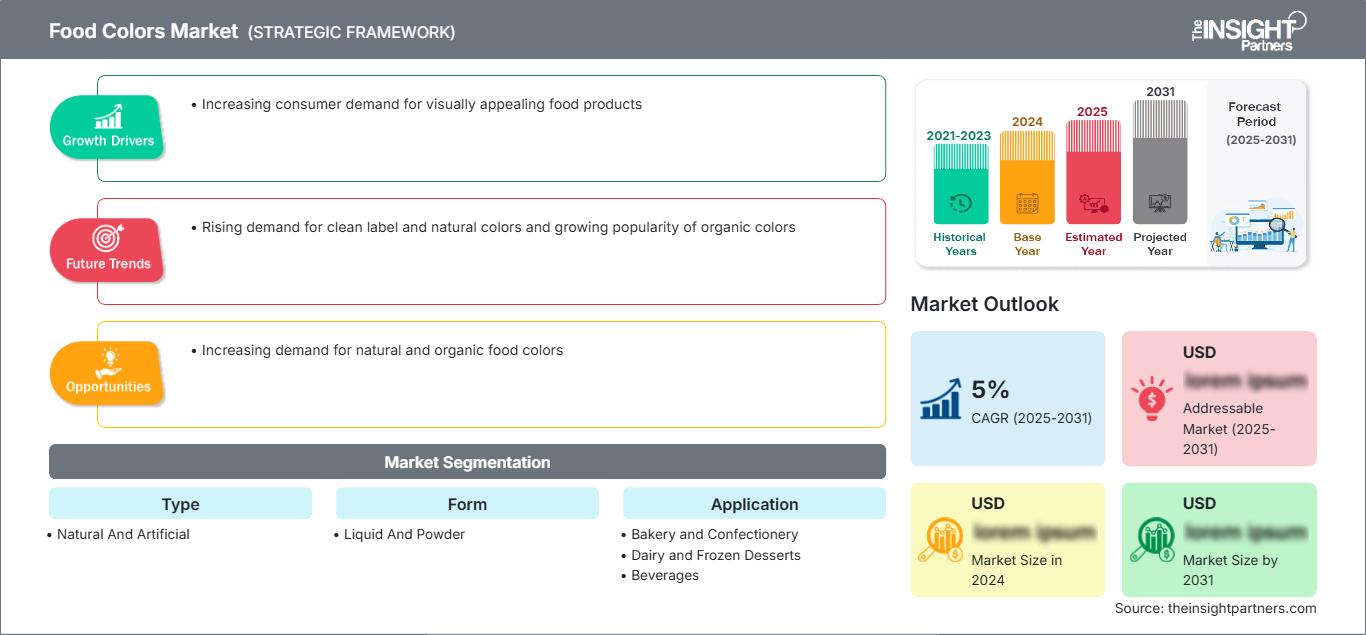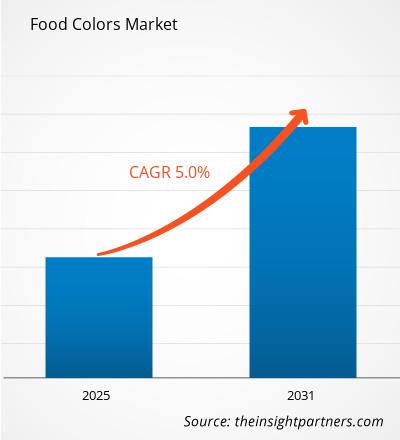식품 색소 시장 규모는 2031년까지 65억 5천만 달러에 이를 것으로 예상됩니다. 2025년부터 2031년까지 연평균 성장률(CAGR)은 6.7%에 이를 것으로 예상됩니다. 클린 라벨 및 천연 색소에 대한 수요 증가와 유기농 색소의 인기 증가는 앞으로도 시장의 주요 트렌드로 남을 것으로 예상됩니다.
식품 색소 시장 분석
- 글로벌 식품 색소 시장은 상당한 속도로 성장하고 있습니다. 성장 요인으로는 가공식품과 편의식품에 대한 수요 증가, 향상된 맛, 질감, 외관에 대한 소비자의 선호 등이 있습니다. 주요 성장 요인으로는 급속한 도시화, 식생활 변화, 가처분 소득 증가 등이 있습니다.
- 시장은 유형, 형태, 용도별로 세분화됩니다.
- 식품 색소의 적용 분야는 빵, 과자, 간식, 육류 제품 등 광범위한 식품을 포함합니다.
- 이 분야의 주요 업체들은 혁신적인 제품 개발, 특히 클린 라벨과 유기농 색소에 집중하고 있으며, 장기 보관이 가능한 식품에 대한 소비자 수요가 꾸준히 증가함에 따라 간접적으로 식품 색소 시장의 입지를 넓히고 있습니다.
식품 색소 시장 개요
- 식용 색소는 음식과 음료의 외관을 향상시키거나 바꾸는 데 사용되는 첨가물입니다.
- 색소는 크게 천연 색소와 합성 색소로 구분할 수 있습니다. 천연 식품 색소는 비트, 강황, 카민, 스피룰리나와 같은 식물, 동물 또는 광물에서 추출됩니다.
- 소비자들이 클린 라벨 제품에 대한 수요를 보이면서 이러한 제품의 인기가 점점 높아지고 있습니다.
- 합성 식품 색소는 인공 색소라고도 하며 화학적으로 생산되며 적색 40호, 황색 5호, 청색 1호와 같은 화합물이 포함됩니다. 이러한 색소는 더욱 생생하고 안정적인 색상을 제공하지만 건강상의 문제로 인해 엄격한 규제를 받습니다.
- 식용 색소는 액체, 분말, 젤, 페이스트 등 다양한 형태로 나옵니다.
이 보고서의 일부 또는 국가 수준 분석, Excel 데이터 팩을 포함하여 모든 보고서에 대한 사용자 정의를 무료로 받을 수 있으며, 스타트업 및 대학을 위한 훌륭한 혜택과 할인도 이용할 수 있습니다.
식품 색소 시장: 전략적 통찰력

-
이 보고서의 주요 시장 동향을 알아보세요.이 무료 샘플에는 시장 동향부터 추정치 및 예측까지 다양한 데이터 분석이 포함됩니다.
시각적으로 매력적인 식품에 대한 소비자 수요 증가로 인해 식품 색소 시장이 성장할 것으로 예상됩니다.
- 시각적으로 매력적인 식품에 대한 소비자 선호도가 높아지면서 식품 색소 시장 확대를 촉진하는 핵심 요인으로 떠올랐습니다.
- 이러한 추세는 다면적이며 다양한 사회적, 기술적 요인의 영향을 받습니다.
- 특히 인스타그램과 핀터레스트와 같은 소셜 미디어 플랫폼의 보편성은 음식의 미적 감각을 전례 없는 수준으로 끌어올렸고, 식사를 전 세계적으로 공유되는 시각적 경험으로 바꾸었습니다.
- 식품을 디지털로 보여주는 이러한 쇼케이스는 소비자의 기대치를 높여, 식품 제조업체가 제품의 시각적 매력을 우선시하게 만들었습니다.
천연 및 유기농 식품 색소에 대한 수요 증가
- 천연 및 유기농 식품 색소에 대한 수요가 급증하고 있으며, 이는 소비자 선호도, 규제 압력, 업계 동향이 합쳐져 식품 색소 시장에 중요한 기회를 제공합니다.
- 이러한 변화는 소비자들 사이에서 건강에 대한 의식이 높아지고, 합성 첨가물에 대한 경계심이 커지고, 깨끗하고 알아볼 수 있는 성분이 들어간 제품을 찾는 데 기인합니다.
- 클린 라벨 운동은 상당한 추진력을 얻었으며, 이로 인해 식품 제조업체는 과일, 채소 및 기타 식물성 원료에서 추출한 천연 착색제를 사용하여 제품을 재구성하게 되었습니다.
- 전 세계의 규제 기관은 인공 식품 첨가물에 대한 제한을 강화하고 있으며, 이로 인해 천연 대체 식품으로의 전환이 더욱 촉진되고 있습니다.
식품 색소 시장 보고서 세분화 분석
식품 색소 시장 분석에 기여한 주요 부문은 유형, 형태, 응용 분야입니다.
- 식품 색소 시장은 유형에 따라 천연 색소와 인공 색소로 구분됩니다.
- 식용 색소 시장은 형태에 따라 액체형과 분말형으로 구분됩니다.
- 식품 색소 시장은 용도에 따라 제빵 및 제과, 유제품 및 냉동 디저트, 음료, RTC 및 RTE 제품, 소스 드레싱 및 조미료, 육류, 가금류 및 해산물 등으로 세분화됩니다.
지역별 식품 색소 시장 점유율 분석
- 식품 색소 시장 보고서는 북미, 유럽, 아시아 태평양(APAC), 중동 및 아프리카(MEA), 남미 및 중미를 포함하여 현재 및 과거 시장 규모와 2021년부터 2031년까지의 예측을 포함하는 5개 주요 지역에 대한 자세한 분석으로 구성되어 있습니다.
- 각 지역은 국가별로 세분화됩니다. 이 보고서는 18개국 이상에 대한 분석 및 예측을 제공하며, 지역 수준에서 시장에 영향을 미치는 성장 동력, 트렌드, 기회 등 식품 색소 시장 역학을 다룹니다.
- 또한, 이 보고서는 포터의 5가지 힘 분석을 다루고 있는데, 이는 이 지역의 식품 색소 시장에 영향을 미치는 주요 요인에 대한 연구를 포함합니다.
식품 색소 시장 지역별 통찰력
The Insight Partners의 분석가들은 예측 기간 동안 식품 색소 시장에 영향을 미치는 지역별 동향과 요인을 면밀히 분석했습니다. 이 섹션에서는 북미, 유럽, 아시아 태평양, 중동 및 아프리카, 그리고 중남미 지역의 식품 색소 시장 세분화 및 지역별 분포도 살펴봅니다.
식품 색소 시장 보고서 범위
| 보고서 속성 | 세부 |
|---|---|
| 2024년 시장 규모 | XX억 달러 |
| 2031년까지 시장 규모 | 65억 5천만 달러 |
| 글로벌 CAGR(2025~2031년) | 6.7% |
| 역사적 데이터 | 2021-2023 |
| 예측 기간 | 2025-2031 |
| 다루는 세그먼트 |
유형별
|
| 포함된 지역 및 국가 |
북아메리카
|
| 시장 선도 기업 및 주요 회사 프로필 |
|
식품 색소 시장 참여자 밀도: 비즈니스 역학에 미치는 영향 이해
식품 색소 시장은 소비자 선호도 변화, 기술 발전, 그리고 제품의 효능에 대한 인식 제고 등의 요인으로 최종 사용자 수요가 증가함에 따라 빠르게 성장하고 있습니다. 수요가 증가함에 따라 기업들은 제품 라인업을 확장하고, 소비자 니즈를 충족하기 위한 혁신을 추진하며, 새로운 트렌드를 적극 활용하고 있으며, 이는 시장 성장을 더욱 가속화하고 있습니다.

- 식품 색소 시장 주요 주요 기업 개요를 알아보세요
식품 색소 시장 소식 및 최근 동향
식품 색소 시장은 1차 및 2차 조사 이후 주요 기업 간행물, 협회 데이터, 데이터베이스 등 정성적 및 정량적 데이터를 수집하여 평가합니다. 식품 색소 시장의 몇 가지 동향은 다음과 같습니다.
- Phytolon과 Ginkgo Bioworks, 두 가지 생산 균주를 통해 선명한 천연 식용 색소 생산에 첫 번째 이정표 달성 (출처: Ginkgo Bioworks 뉴스레터, 2024년 1월)
- 오테라의 새로운 레드 앤 핑크 내추럴 컬러는 '식물 대 식물'이라는 스마트한 조합을 선보입니다. (출처: 오테라 뉴스레터, 2023년 6월)
식품 색소 시장 보고서 범위 및 성과물
"식품 색소 시장 규모 및 예측(2021~2031)" 보고서는 아래 영역을 포괄하여 시장에 대한 자세한 분석을 제공합니다.
- 범위에 포함된 모든 주요 시장 부문에 대한 글로벌, 지역 및 국가 수준의 식품 색소 시장 규모 및 예측
- 식품 색소 시장 동향 및 동인, 제약 및 주요 기회와 같은 시장 역학
- 자세한 PEST/포터의 5가지 힘 및 SWOT 분석
- 주요 시장 동향, 글로벌 및 지역 프레임워크, 주요 참여자, 규정 및 최근 시장 개발을 포괄하는 식품 색소 시장 분석
- 시장 집중도, 히트맵 분석, 주요 업체 및 식품 색소 시장의 최근 동향을 다루는 산업 환경 및 경쟁 분석
- 자세한 회사 프로필
- 과거 분석(2년), 기준 연도, CAGR을 포함한 예측(7년)
- PEST 및 SWOT 분석
- 시장 규모 가치/거래량 - 글로벌, 지역, 국가
- 산업 및 경쟁 환경
- Excel 데이터세트
최근 보고서
관련 보고서
사용 후기
구매 이유
- 정보에 기반한 의사 결정
- 시장 역학 이해
- 경쟁 분석
- 고객 인사이트
- 시장 예측
- 위험 완화
- 전략 기획
- 투자 타당성 분석
- 신흥 시장 파악
- 마케팅 전략 강화
- 운영 효율성 향상
- 규제 동향에 발맞춰 대응






















 무료 샘플 받기 - 식품 색소 시장
무료 샘플 받기 - 식품 색소 시장